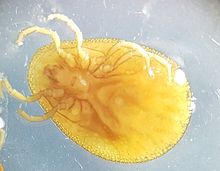
Argas persicus

Argas persicus appears yellowish-brown when starved and slatey-blue when engorged. They are found on an animal host, in cracks and crevices of buildings or in nests. They are also carriers of the spirochete bacteria Borrelia anserina which causes avian spirochetosis, one of the most severe diseases affecting the poultry industry. In addition to domestic fowl, A. persicus may also feed on humans, although an immunity has been acquired by some individuals. The fowl tick is distributed worldwide but does tend to prefer a warmer climate. The lower United States especially sees a large distribution of this soft bodied tick due to the warm climate. Argasid (soft) ticks have a multihost life cycle meaning it has two or more nymphal stages that each require a blood meal. Mating and the laying of eggs occurs off the host and in sheltered areas such as bird nests. Six-legged larvae hatch from the eggs in the chosen sheltered area. Once a suitable host is found in the vicinity, they begin to feed for a few hours to a few days. The larvae finish feeding and leaves the host for an area of shelter. The larvae then molt to become the first nymph stage. The first nymphs stage then move onto the second host to feed. This second host may be the same individual as the first and is likely the same species. The first stage of nymphs transforms to the next nymph stage when it leaves the host and molts once more. These nymph stages can reach up to seven stages. After the last nymph stage, it leaves the host to molt into an adult. The adults can continue to feed on the host feeding quickly and detaching from the host after each blood meal. Females often lay eggs after each meal when off the host. A. persicus is a natural reservoir for B. anserina as it helps these spirochetes survive longer.West Nile virus was also found to be able to infect the tick when feeding on an infected membrane. This was tested using artificial inoculation.If the pathogen infects humans due to A. persicus, it would likely be as an incidental host but humans may be fed upon by any of the stages.
